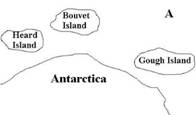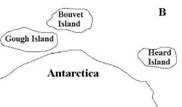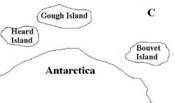
题目列表(包括答案和解析)
A strong wind can be a dangerous thing — sometimes it is powerful enough to knock you off your feet. But to plants, the wind is a source of new life, carrying them or their spores (孢子) thousands of miles.
A NASA satellite called QuikSCAT has discovered highways of wind over the Earth's oceans. Scientists believe these invisible roads may explain why many nonflowering plants, such as mosses (苔) and lichens (地衣), grow where they do.
The satellite is able to send microwaves (微波) from space to the surface of the ocean. The pattern of signals that come back shows which way the winds are blowing.
Using this data, the scientists studied a group of islands in the southern hemisphere (半球), near Antarctica.Winds tend to blow anticlockwise (逆时针) in this region, but there are lots of local differences.
When the researchers compared these local patterns to botanical (植物学) data, they found that the wind had an important effect on where species of mosses, lichens, and other nonflowering plants grow.
For example, Bouvet Island and Heard Island, share 30 per cent of their moss species, 29 per cent of liverworts (叶苔), and 32 per cent of lichens — even though they are 4,430 kilometers apart. In contrast, Gough Island and Bouvet Island, separated by just 1,860 kilometers of sea, share only 16 per cent of mosses and 17 per cent of liverworts. They have no lichens in common.
Ferns (蕨类植物) and flowering plants don't travel as well in the wind, so they don't show the same kinds of distribution (分布) patterns.
This story is about _____.
A.the discovery of wind highways B.how wind travels
C.how wind affects different plants D. one function of the wind
The underlined word "data" in the fourth paragraph means _____.
A.signal B.pattern C.information D. research
Which of the following is wrong?
A.Bouvet Island, Heard Island and Gough Island are all in the southern hemisphere.
B.Winds in the researched area blow anti-clockwise.
C.The scientists shouldn't base this research on how winds affect where ferns grow.
D. Without the discovery of QuikSCAT, the research wouldn't have made sense.
Which of the following diagrams shows the correct position of the islands?




A strong wind can be a dangerous thing-sometimes it is powerful enough to knock you off your feet.But to plants,the wind is a source of new life,carrying them or their spores(孢子)thousands of miles.
A NASA satellite called QuikSCAT has discovered highways of wind over the Earth's oceans.Scientists believe these invisible roads may explain why many nonflowering plants,such as mosses(苔藓)and lichens(地衣),grow where they do.
The satellite is able to send microwaves(微波)from space to the surface of the ocean.The pattern of signals that come back shows which way the winds are blowing.
Using this data, the scientists studied a group of islands in the southern hemisphere(半球),near Antarctica.Winds tend to blow anticlockwise(逆时针)in this region,but there are lots of local differences.
When the researchers compared these local patterns to botanical(植物学)data,they found that the wind had an important effect on where species of mosses,lichens,and other nonflowering plants grow.
For example,Bouvet Island and Heard Island,share 30 percent of their moss species,29 percent of liverworts(叶苔),and 32 percent of lichens-even though they are 4,430 kilometers apart.In contrast,Gough Island and Bouvet Island,separated by just 1,860 kilometers of sea,share only 16 percent of mosses and 17 percent of liverworts.They have no lichens in common.
Ferns(蕨类植物)and flowering plants don't travel as well in the wind,so they don't show the same kinds of distribution(分布)patterns.
67.This story is about .
A.the discovery of wind highways B.how wind travels
C.how wind affects different plants D.one of the wind
68.The underlined word “data” in the fourth paragraph means .
A.signal B.pattern C.information D.research
69.Which of the following is WRONG?
A.Bouvet Island,Heard Island and Gough Island are all in the southern hemisphere.
B.Winds in the researched areas blow anticlockwise.
C.The scientists needn't base this research on how winds affect where ferns grow.
D.Without the QuikSCAT,the research wouldn't have made sense.
70.Which of the following diagrams shows the correct position of the islands?

| |||||||||||||||||||||||||||||||||||||||||||||||||||||||||||
湖北省互联网违法和不良信息举报平台 | 网上有害信息举报专区 | 电信诈骗举报专区 | 涉历史虚无主义有害信息举报专区 | 涉企侵权举报专区
违法和不良信息举报电话:027-86699610 举报邮箱:58377363@163.com